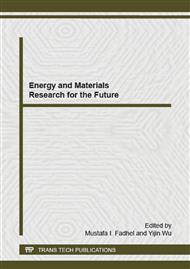[1]
J. Sengupta, B.G. Thomas, and M.A. Wells, The use of water cooling during the continuous casting of steel and Aluminum alloys, Metallurgical and Materials Transactions A, Vol. 36 (2005) p.187–204.
DOI: 10.1007/s11661-005-0151-y
Google Scholar
[2]
E.J.F.R. Caron, M.A. Wells, Effect of advance cooling front (ACF) phenomena on film boiling and transition boiling regimes in the secondary cooling zone during the direct-chill casting of aluminum alloys, Material Science Forum Vol. 519-521 (2006).
DOI: 10.4028/www.scientific.net/msf.519-521.1687
Google Scholar
[3]
J. Filipovic, F.P. Incropera, R. Viskanta, Quenching phenomena associated with a water wall jet: 1. Transient hydrodynamic and thermal conditions. Experimental Heat Transfer, Vol. 8 (1995) p.97–117.
DOI: 10.1080/08916159508946494
Google Scholar
[4]
M.A. Islam, M. Monde, P.L. Woodfield, Y. Mitsutake, Jet impingement quenching phenomena for hot surfaces well above the limiting temperature for solid–liquid contact. Int. J. Heat Mass Transfer, Vol. 51 (2008) p.1226–1237.
DOI: 10.1016/j.ijheatmasstransfer.2007.01.059
Google Scholar
[5]
A.K. Mozumder, M. Monde, P.L. Woodfield, M.A. Islam, Maximum heat flux in relation to quenching of a high temperature surface with liquid jet impingement. Int. J. Heat Mass Transfer, Vol. 49 (2006) p.2877–2888.
DOI: 10.1016/j.ijheatmasstransfer.2006.01.048
Google Scholar
[6]
A.K. Mozumder, P.L. Woodfield, M.A. Islam, M. Monde, Maximum heat flux propagation velocity during quenching by water jet impingement. Int. J. Heat Mass Transfer, Vol. 50 (2007) p.1599–1568.
DOI: 10.1016/j.ijheatmasstransfer.2006.08.035
Google Scholar
[7]
J.A. Hammad, Characteristics of Heat Transfer and Wetting Front During Quenching High Temperature Surface by Jet Impingement, Transactions of the Japan Society of Mechanical Engineers, Part B, Vol. 70 (2004) p.1510–1517.
DOI: 10.1299/kikaib.70.1510
Google Scholar
[8]
U. Alam, Experimental Study of Local Heat Transfer during Quenching of Metals by Spray and Multiple Jets, PhD thesis in Process and System Engineering Faculty, Otto-von-Guericke-Universität Magdeburg: Magdeburg (2011).
DOI: 10.46720/f2021-adm-142
Google Scholar
[9]
K.H.M. Abdalrahman, Influence of Water Quality and Kind of Metal in the Secondary Cooling Zone of Casting Process, PhD thesis in Process and System Engineering Faculty, Otto-von-Guericke-Universität Magdeburg: Magdeburg (2012) p.131.
DOI: 10.46720/f2021-adm-142
Google Scholar
[10]
A.K. Nallathambi, E. Spect, Estimation of heat flux in array of jets quenching using experimental and inverse finite element method, J. Material processing technology Vol. 209 (2009) pp.5325-5332.
DOI: 10.1016/j.jmatprotec.2009.04.001
Google Scholar
[11]
P.L. Woodfield, A.K. Mozumder, M. Monde, On the size of the boiling region in jet impingement quenching, Int. J. Heat Mass Transfer, Vol. 52 (2009) p.460–465.
DOI: 10.1016/j.ijheatmasstransfer.2008.05.024
Google Scholar
[12]
H.R. Müller, Wärmeübergang bei der spritzwasserkühlung von nichteisenmetallen, Fakultät für Bergbau, Hüttenwessen und Maschinenwesen, Technischen Universität Clausthal, Dissertation (1982).
Google Scholar


